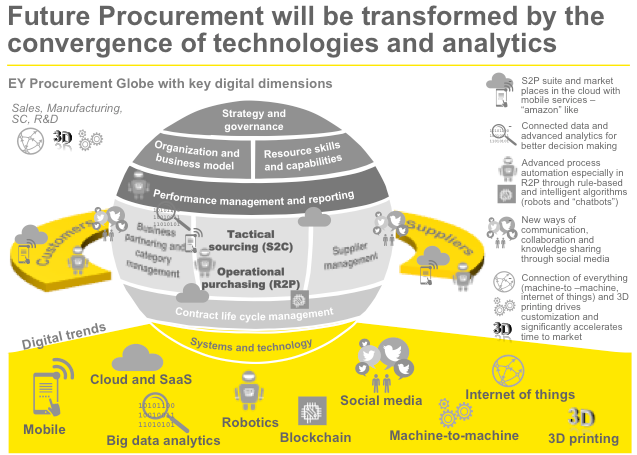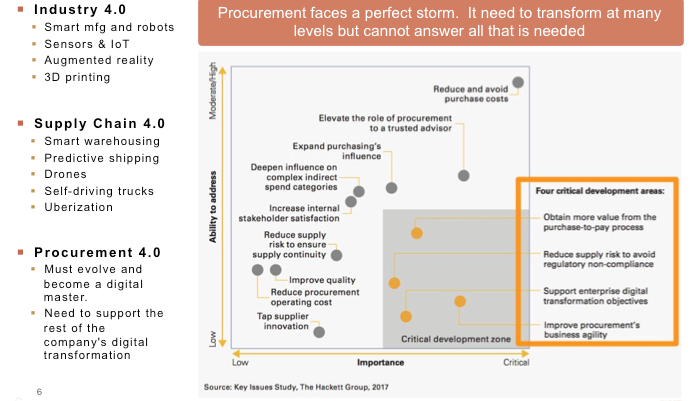eProcurement
What are the traditional eProcurement methods? What are
their pros and cons?
According
to Claritum, a traditional procurement process is characterised by manual
events, including many small, repetitive tasks (from approvals, writing RFxs
contracts, negotiations and discussions of bids).
Typical phone calls between a buyer and a seller are time consuming and can take an average of six minutes per call for basic interactions
Typical phone calls between a buyer and a seller are time consuming and can take an average of six minutes per call for basic interactions
- Time consuming and expensive in resource terms
- Managing the approvals, invoices and bills on paper is both wasteful and costly and of course prone to errors and loss of paperwork
- Sufficient people in demand to manage the processes, with business expansion resulting in a direct correlation to increased headcount
History of eProcurement
2001: Zeborg, later acquired by
Emptoris, along with Verticalnet and Softface, later acquired by Ariba, adopted
the first "automated spend analysis" application
2002:
- Aentropy, later acquired by Ketera, and Zycus appeared with slightly
different offerings
- Tigris and Silver Oak Solutions, specialist consulting
outfits, used analytic tools along with consultants to address the all-manual
approach used in the past with a slight change in content
- D&B and Austin-Tetra started offering services for
supplier intelligence
- Pure content providers such as Intigma, which was
also later acquired by Emptoris, developed cutting-edge technology for
classification and supplied sub-contracting services to major spend analysis
providers
2004: Verticalnet acquired Tigris
to gain its vendor and product classification expertise and consultants.
(Pandit & Marmanis 2018)
Presutti (2003) believes that an
e-procurement system is an information technology-based procuring system that
lies at the input end of the supply chain.
Required Internet technologies The technologies that are
needed to enable staff of an organization to implement eProcurement are
marketplaces, intranet and extranet (Boer, Hanrik & Heijboer 2001).
Boer, Harink, & Heijboer (2001) state that there are
basically five main forms of e-procurement: web-based ERP
- e-sourcing
- e-tendering
- e-reverse auctioning
- e-informing
- e-MRO as well as web-based ERP
(Mahdillou & Akbary 2014)
What are the current eProcurement methods? What are their
pros and cons?
Comparison of Traditional vs. e-Procurement (Sheffi)
Current Trends:
- Next Gen Spend Analytics: Spend analytics has
moved beyond aggregating and analyzing transactional data, to gathering
strategic intelligence. Supplier performance & risk information must be
integrated into spend analysis to present a truly holistic view of an
enterprise’s spend behavior. This is achieved by taking advantage of 3rd party
information sources, such as local news media coverage.
- Digital Capabilities Adoption for Indirect Spend: Companies
have begun to realize that reducing indirect spend, offers a huge opportunity,
by affecting its cost structure. To drive maturity in indirect spend, companies
have incorporated cloud based technologies to create an “amazon-like” experience,
with real time market view for buyers.
- Best Cost Country Sourcing: There has been a
steady shift in strategy around low-cost country sourcing to best-cost country
sourcing. Companies have understood that source choice should be based, not
only on a static view of total cost of ownership (TCO), but on future costs,
alternative growth markets, and approaches to implementing greener and leaner
supply chains.
- Supply Chain Sustainability: Consumers are
becoming aware of how products are sourced and manufactured. Supply chain
sustainability has therefore, become an important factor today with more
companies pushing towards positive social change and environmental protection.
(Viswanathan 2018)
The digital applications that will make a real difference
to a company’s procurement performance fall into two broad areas: tools
that identify and create value, and tools that prevent
value leakage
(Boulaye, Riedstra & Spiller 2017)
2017 Focus On Driving Efficiency And Increasing
Agility


(Breault 2018)
How can companies optimize the best eProcurement methods
for their sourcing management?
Many
companies have adopted eProcurement software systems, with varying levels of
success. Some achieved the touted benefits of automation and efficiency that
early eProcurement software promoters hyped. Others had much less success and,
in some cases, have had to abandon their eProcurement efforts.
Challenges with
eProcurement Software (Why eProcurement software may be not be the method
of choice for a given enterprise?)
Lack of partner
buy-in is a compelling obstacle. If suppliers aren’t
participating in these types of digital platforms, it can spell trouble for
procurement models.
Confusing mix of
vendor options and solutions. Cross-compatibility
has seemed to be a big issue for the businesses that couldn’t solve the
eProcurement puzzle. With so many voices in play, it’s difficult to be diligent
in researching any kind of software vendor, and eProcurement software is no
exception.
It is difficult to
tie to other parts of the architecture. Many businesses
consider enterprise resource planning to be the center or hub of a business’
digital toolbox. There’s the urgency of tying eProcurement solutions into ERP,
as well as integrating it with CMMS or other maintenance software. When these
tasks become less feasible, eProcurement software becomes less desirable to a
company.
Incorrectly implement
eProcurement software systems. There’s a sense that
many companies put eProcurement software in place just to “automate the process
of wasting money.
(SelectHub)
Digitalizing
processes is a massive opportunity whose real challenge is to integrate
technology and insights in a way that is both progressive and supports business
needs at each step of the journey.
A roadmap for change
and align it with enterprise-level digital transformation initiatives:
1) Define a digital
roadmap and vision:
Strategy needs to
support organization’s overall approach to leveraging digital technologies to
transform its business model and ensure that each investment in a digital capability
must have beneficial business outcome.
2) Align with
organizational strategy:
On their own, big
data, or predictive analytics or any of the other so-called ‘digital’ enablers
are not valuable as stand alone technologies. Outcomes need to help the
business make decisions and drive actions that are consistent with the overall
company objectives and digital plan. Any discrepancies between the two can
create “technology islands” and put procurement at odds with corporate
objectives.
3) Build a Digital
competency within procurement to understand, master and lead the prioritised
acquisition and implementation of digital tools.
(Breault 2018)
References
Boulaye, P., Riedstra, P. and Spiller, P (2017). Driving
superior value through digital procurement. McKinsey&Company.
URL: https://www.mckinsey.com/industries/consumer-packaged-goods/our-insights/driving-superior-value-through-digital-procurement. Accessed
on: 24 September 2018.
Breault, G. 2018. Procurement Agility in the Age of Digitalisation.
The Startup. Medium. URL:
https://medium.com/swlh/procurement-agility-in-the-age-of-digitalisation-e5b9a71da9dd. Accessed
on: 24 September 2018.
Mahdillou, H & Akbary, J 2014. E-Procurement
Adoption, Its Benefits And Costs: Academic Literature Review. University of
Borås. Borås.
Sweden. URL: http://bada.hb.se/bitstream/2320/14364/1/Mahdillou%20Akbary.pdf. Accessed
on: 24 September 2018.
Pandit, K. & Marmanis, H. 2018. Spend Analysis: The
Window Into Strategic Sourcing. J.Ross Publishing. USA.
SelectHub. Is eProcurement Software Dead?. SelectHub.
URL: https://selecthub.com/eprocurement/eprocurement-software-dead.
Accessed on: 24 September 2018.
Sheffi, Y. Modern Procurement. Mass Institute of Tech.
Cambridge. MA. URL: http://www.ocw.nur.ac.rw/NR/rdonlyres/Engineering-Systems-Division/ESD-260JFall2003/1FFAD3C7-EF76-4E29-B27F-33D782C76BAD/0/l19procauctcomb.pdf.
Accessed on: 24 September 2018.
Viswanathan, A. 2018. The Evolution Of
Procurement: Past, Present, Future – Part 1 Of 2. CGN Global. URL: http://www.cgnglobal.com/blog/69. Accessed on: 24 September 2018.




Comments
Post a Comment